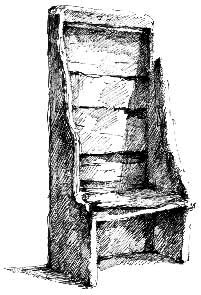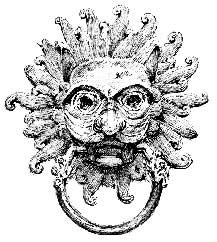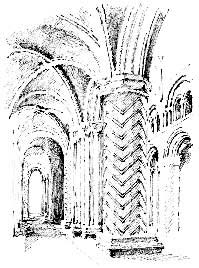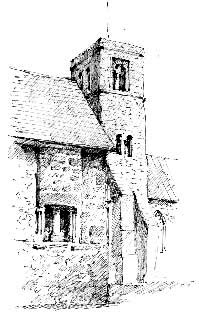County Durham
COUNTY PALATINE ∗ FINEST NORMAN BUILDING
∗ SANCTUARY ∗ NEVER FELL TO THE SCOTS ∗ PRINCE BISHOPS ∗ THIRD UNIVERSITY ∗ ONLY ORIENTAL MUSEUM
Sanctuary Knocker on the door of Durham Cathedral.
DURHAM FOLK
Bede ∗ Elizabeth Barrett Browning ∗ William Wouldhave ∗ Ernest Thompson Seton ∗ Dame Flora Robson ∗ Catherine Cookson ∗ Captain Richard Wallace Annand ∗ Ridley Scott ∗ Eric Idle
Durham
The name Durham comes from the Old English ‘dun-holm’, which means ‘hill-island’, an apt description of the 98 ft (30 m) high sandstone rock on which Old Durham Town stands.
The story of Durham begins in 995 when monks guarding the relics of St Cuthbert, then resting at Chester-le-Street, were led to the spot by a milk-maid looking for her dun cow. They found the cow lying high up on the rock which, being surrounded on three sides by the River Wear, made a good secure site on which to establish a church to serve as Cuthbert’s permanent shrine. It soon became one of England’s principal places of pilgrimage for both Saxons and Normans, and in 1093 the present cathedral was begun.
Cathedral
DURHAM CATHEDRAL as we see it today is not that much changed from the original 11th-century conception, and with its massive round pillars, some with spiral or zigzag decoration, it is undoubtedly England’s finest Romanesque or Norman cathedral – some commentators regard Durham as the greatest Norman building in the world. It was also ENGLAND’S EARLIEST VAULTED CATHEDRAL, and THE FIRST TO USE RIB VAULTS.
A vault is a stone roof, found in a few churches and most cathedrals. A rib vault is one that features projecting stone strips, used either for decoration or for structural purposes. The most decorative type of rib vault is fan vaulting, as found in places such as King’s College Chapel at Cambridge or Henry VII’s Chapel in Westminster Abbey.
On the main entrance door of Durham Cathedral hangs a huge SANCTUARY KNOCKER, a relic of the days when Durham Cathedral offered sanctuary from the law. Any criminal who banged on the knocker would be admitted to the cathedral, and fed and protected from his pursuers. In return the fugitive would be obliged to don a black robe and confess his crime, and at the end of 37 days he would be sent to Durham’s assigned port of Hartlepool and told to leave the country. If he disobeyed any of these conditions, the criminal would be handed over to the law. Over a period of some 50 years in the late 15th and early 16th centuries, some 330 offenders, including 280 murderers, were given sanctuary at Durham, and even King Edward IV was unable to extract an escaped prisoner accused of treason.
One of Durham Cathedral’s most precious treasures is a stole given to St Cuthbert’s shrine by King Athelstan in 934, and thought to be THE OLDEST EXAMPLE OF ENGLISH NEEDLEWORK IN EXISTENCE. The cathedral is also the resting-place of THE VENERABLE BEDE, who died in 735.
Durham’s Bishop’s Throne is THE HIGHEST BISHOP’S CHAIR IN CHRISTENDOM.
Castle
DURHAM CASTLE was begun by William the Conqueror in 1072, during his ‘harrying of the North’, and was the only northern castle never to fall to the Scots. Because Durham was far from London and yet in a strategically vital position on the main route from London to Scotland, William relied on the Bishops of Durham to protect and rule the North in his interests, and granted them immense powers to raise their own taxes and armies, administer their own laws and even mint their own coins. Durham Castle served as the Bishop’s Palace.
In 1986 Durham Cathedral and Castle together became one of England’s first World Heritage Sites.
Prince Bishops
THE COUNTY PALATINE OF DURHAM was created by William the Conqueror to defend England’s northern border with Scotland. It was carved out of the old Saxon kingdom of Northumbria, Durham lying south of the Tyne and Derwent rivers and Northumberland to the north. Within Durham the Bishops ruled like princes and were known as PRINCE BISHOPS, a description applied to them until the time of the Great Reform Act in 1832.
Durham University
DURHAM UNIVERSITY was founded in 1832 by the last Prince Bishop, William Van Mildert, as ENGLAND’S THIRD UNIVERSITY, after Oxford and Cambridge. The Bishops of Durham moved their principal residence to Bishop Auckland and gave over the castle to the new university.
The university’s ORIENTAL MUSEUM is ENGLAND’S ONLY MUSEUM DEVOTED WHOLLY TO ORIENTAL ART AND ARCHITECTURE.
Durham Miners’ Gala
The 19th century saw Durham become a centre of the English coal-mining industry, and an important part of Durham’s heritage is the annual DURHAM MINERS’ GALA, when representatives of each mining village and union march behind banners and brass bands to meet at Durham race course for speeches and merriment. Established in 1871, this is England’s oldest and best-known celebration of trade union pride and tradition.
THE DURHAM REGATTA, held in June, was inaugurated in 1834 and is ENGLAND’S OLDEST REGATTA.
Well, I never  knew this
knew this
about
DURHAM FOLK
The Venerable Bede
The ancient town of JARROW grew up around a monastery founded in 682 by a Northumbrian nobleman, Benedict Biscop, and for more than 50 years it was the home of the brilliant monk known as THE FATHER OF ENGLISH LEARNING, the VENERABLE BEDE.
Born in MONKWEARMOUTH in 673, Bede was THE FIRST PERSON TO WRITE EXTENSIVELY IN THE ENGLISH LANGUAGE. His Ecclesiastical History of the English People is the earliest and most important record we have of English history until 729, and tells us about the beginnings of Christianity in these islands, up to the Synod of Whitby in 664. He was also the first historian to date events from the Year of our Lord, Anno Domini. On the very day he died in 735, the Venerable Bede completed an Old English translation of the Gospel of St John. He was buried at Jarrow, but 300 years later his relics were stolen by a monk, who took them to Durham, where they now lie in the cathedral’s Galilee Chapel.

The church of St Paul, attached to the monastery, was dedicated in 685 and the original dedication stone, THE OLDEST DEDICATION STONE IN ENGLAND, is still in place above the chancel arch. The arch has survived, along with much of the chancel itself, from Bede’s day. One of the windows in the south wall contains the oldest Saxon stained glass of its kind in Europe. A battered wooden seat known as Bede’s Chair sits against a wall.
The church and monastery ruins, one of the most significant Christian shrines in England, occupy a rather bleak site beside a muddy creek, but it has all been jollied up as ‘Bede’s World’, a modern interpretation centre.
Jarrow March
Twelve hundred years after Bede, in 1936, the name of Jarrow reverberated throughout the country once again, when the men of Jarrow marched to London. Unemployment in the north-east, particularly among miners and shipbuilders, was horrendous, around 80 per cent, and 200 men set off from Jarrow to lobby Parliament for jobs and recognition of their plight. Wherever they stopped for the night, local people provided them with food and shelter. The Jarrow March took almost one month, and when they arrived in London, the MP for Jarrow, Ellen Wilkinson, handed in a petition of 12,000 signatures, which Prime Minister Stanley Baldwin ignored, refusing even to meet the marchers. Although the march did not achieve very much at the time, it was a significant landmark in the struggle for the rights of England’s working men.
ELIZABETH BARRETT BROWNING (1806–61), poet, was born at COXHOE, south of Durham. One of the most quoted opening lines in the English language comes from her Sonnets from the Portuguese – ‘How do I love thee? Let me count the ways.’
Born in South Shields
WILLIAM WOULDHAVE (1751–1821), inventor of the lifeboat.
ERNEST THOMPSON SETON (1860–1946), founder of the Boy Scouts of America.
DAME FLORA ROBSON (1902–84), character actress and theatrical grande dame.
CATHERINE COOKSON (1906–98) the most widely read English novelist of the later 20th century.
CAPTAIN RICHARD WALLACE ANNAND (1914–2004), of the Durham Light Infantry, the first recipient of the Victoria Cross in the Second World War.
SIR RIDLEY SCOTT, film director (Alien, Blade Runner, Gladiator), born 1937.
ERIC IDLE, comic actor, writer and member of the Monty Python team, born 1943.










 knew this
knew this

